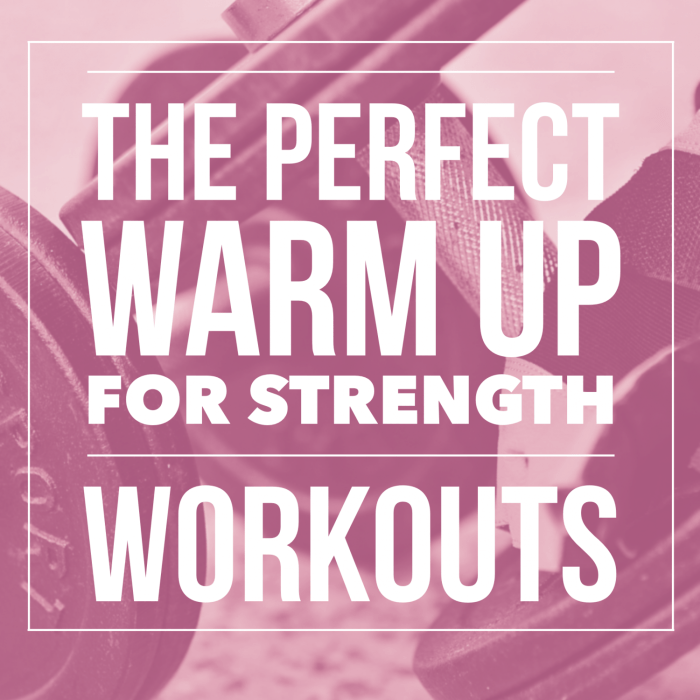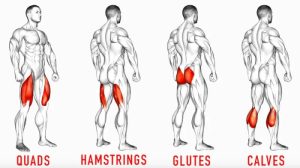
Strength training is a fantastic way to build muscle, improve strength, and enhance overall fitness. However, it’s crucial to prepare your body properly before diving into heavy lifting. A proper warm-up isn’t just about preventing injuries; it’s about maximizing your potential for success in the gym. By taking the time to warm up effectively, you can improve your range of motion, increase muscle activation, and prime your body for peak performance.
This guide will explore the essential components of a comprehensive warm-up routine tailored specifically for strength training. We’ll cover dynamic stretches, muscle activation exercises, and how to tailor your warm-up based on the specific exercises you plan to perform. We’ll also delve into common warm-up mistakes to avoid and discuss the importance of listening to your body.
Understanding the Importance of Warming Up
You might be tempted to jump right into lifting heavy weights, but taking the time to warm up is crucial for a successful and injury-free strength training session. A proper warm-up prepares your body for the demands of exercise, reducing the risk of injury and enhancing performance.
Benefits of Warming Up
A proper warm-up provides several benefits for your body and your workout:
- Increased Muscle Temperature: Warming up increases blood flow to your muscles, delivering oxygen and nutrients, which helps improve muscle elasticity and reduces stiffness. This, in turn, allows for greater range of motion and flexibility, making your workout more efficient and less likely to result in injury.
- Improved Performance: A warm-up primes your nervous system, making your muscles more responsive to signals from your brain. This enhanced communication between your brain and muscles leads to increased strength, power, and speed during your workout.
- Reduced Risk of Injury: Warming up prepares your muscles, tendons, and ligaments for the stresses of strength training. This gradual increase in intensity reduces the risk of muscle strains, tears, and other injuries that can occur when cold muscles are suddenly subjected to heavy loads.
Potential Injuries Without Proper Warm-Up
Failing to warm up properly can increase the risk of various injuries, including:
- Muscle Strains and Tears: Cold muscles are more prone to tearing, especially when subjected to sudden, forceful movements.
- Ligament Sprains: Ligaments, which connect bones, can be stretched or torn when not adequately warmed up. This is particularly true for exercises that involve high impact or sudden changes in direction.
- Tendonitis: Tendons, which connect muscles to bones, can become inflamed when subjected to repetitive stress without proper preparation.
Why Warming Up is Essential for Optimal Performance
Think of warming up as a car engine warming up before hitting the road. A cold engine runs poorly and can be damaged, just like your muscles when they’re not properly prepared. A proper warm-up ensures that your body is ready to perform at its peak. This not only reduces the risk of injury but also helps you lift heavier weights, improve your technique, and achieve better results from your strength training sessions.
Dynamic Warm-up Components

A dynamic warm-up is an essential part of any strength training routine. It prepares your body for the more strenuous activity to come by increasing your heart rate, loosening up your muscles, and improving your range of motion. Dynamic stretches involve controlled movements that mimic the actions you will perform during your workout. This helps to activate the muscles you will be using and improve their flexibility, reducing the risk of injury.
Dynamic Warm-up Routine
Here is a sample dynamic warm-up routine that you can use before your strength training session. It includes exercises that target major muscle groups, including the legs, hips, back, shoulders, and arms.
| Exercise | Description | Sets | Reps |
|---|---|---|---|
| Arm circles | Stand with your feet shoulder-width apart. Extend your arms out to the sides, parallel to the ground. Make small circles with your arms, moving them forward for 10-15 reps, then backward for 10-15 reps. | 1 | 10-15 reps each direction |
| Leg swings | Stand with your feet hip-width apart. Swing one leg forward and back, keeping your leg straight and your core engaged. Repeat on the other side. | 1 | 10-15 reps each leg |
| High knees | Stand with your feet hip-width apart. Bring your knees up towards your chest, as if you are running in place. | 1 | 10-15 reps |
| Butt kicks | Stand with your feet hip-width apart. Bring your heels up towards your glutes, as if you are running in place. | 1 | 10-15 reps |
| Walking lunges | Stand with your feet hip-width apart. Take a large step forward with one leg, bending your knee to a 90-degree angle. Keep your other leg straight behind you. Push off with your front foot to return to the starting position. Repeat on the other side. | 1 | 10-15 reps each leg |
| Side shuffles | Stand with your feet hip-width apart. Take a step to the side, keeping your feet shoulder-width apart. Shuffle side to side, keeping your core engaged. | 1 | 10-15 reps each direction |
| Arm circles | Stand with your feet shoulder-width apart. Extend your arms out to the sides, parallel to the ground. Make small circles with your arms, moving them forward for 10-15 reps, then backward for 10-15 reps. | 1 | 10-15 reps each direction |
Specific Considerations for Strength Training
When it comes to strength training, tailoring your warm-up to the specific exercises you plan to perform is crucial. This ensures you’re adequately preparing your body for the demands of the workout, minimizing the risk of injury, and optimizing performance.
Activating Targeted Muscles
Activating the muscles involved in the targeted lifts is a key aspect of a strength training warm-up. This helps improve neuromuscular efficiency, which is the ability of your nervous system to activate and coordinate your muscles effectively.
“It’s like priming the pump. You want to ensure your muscles are ready to fire when you hit the heavier sets.”
This can be achieved through a variety of methods, including:
- Light-weight sets: Performing a few sets of the planned exercises with very light weights can help prime the muscles and joints for the heavier lifts. This allows you to practice the movement pattern and activate the target muscles without overloading them.
- Bodyweight exercises: Bodyweight exercises, such as squats, lunges, push-ups, and rows, can be a great way to activate major muscle groups without additional weight.
- Dynamic stretches: Dynamic stretches, such as arm circles, leg swings, and torso twists, can help increase blood flow to the muscles and improve range of motion.
Warm-up Approach for Compound vs. Isolation Exercises
The warm-up approach for compound movements, which involve multiple muscle groups, differs slightly from the warm-up for isolation exercises, which focus on a single muscle group.
- Compound Movements: Compound exercises, such as squats, deadlifts, and bench presses, require a more comprehensive warm-up that focuses on activating multiple muscle groups. This can include a combination of light-weight sets, bodyweight exercises, and dynamic stretches targeting the major muscle groups involved in the movement.
- Isolation Exercises: Isolation exercises, such as bicep curls, tricep extensions, and leg extensions, can be warmed up with a more targeted approach.
This could involve a few light-weight sets of the exercise itself, followed by some dynamic stretches specifically targeting the muscle group being worked.
Cool-down and Recovery
A proper cool-down after strength training is essential for promoting muscle recovery, reducing soreness, and preventing injuries. It helps your body gradually transition from a high-intensity workout back to a resting state.
Benefits of a Cool-down
A cool-down helps your body return to a resting state by gradually decreasing your heart rate and blood pressure. It also allows your muscles to relax and prevents blood from pooling in your legs, which can lead to dizziness.
Effective Cool-down Exercises
Here are some examples of effective cool-down exercises that promote flexibility and recovery:
- Static Stretching: Hold each stretch for 30 seconds, focusing on major muscle groups like the quadriceps, hamstrings, calves, chest, and back. This helps improve flexibility and reduce muscle tension.
- Light Cardio: Engage in low-intensity cardio activities like walking or jogging for 5-10 minutes. This helps maintain blood flow and promote recovery.
- Foam Rolling: Use a foam roller to target tight muscles, such as the quads, hamstrings, and back. This helps release muscle tension and improve mobility.
Stretching for Muscle Recovery and Injury Prevention
Stretching is a vital component of a cool-down routine. It helps improve flexibility, range of motion, and muscle recovery. By increasing blood flow to the muscles, stretching can reduce muscle soreness and stiffness. Additionally, regular stretching can help prevent injuries by improving muscle elasticity and reducing the risk of muscle strains or tears.
Factors Influencing Warm-up Duration
The duration of your warm-up can vary depending on several factors. It’s not a one-size-fits-all approach. You’ll need to consider your experience level, the intensity of your workout, and your training goals.
Training Experience
Your experience level significantly influences the duration of your warm-up. Beginners may need a longer warm-up to prepare their bodies for the demands of exercise. Experienced athletes may be able to warm up more quickly due to their developed muscle memory and cardiovascular fitness.
- Beginners: Start with a longer warm-up of 10-15 minutes. This allows your body to gradually increase its temperature and prepare for the workout.
- Intermediate: A 5-10-minute warm-up is usually sufficient.
- Advanced: A 5-minute warm-up might be enough, focusing on dynamic movements that target the muscles you’ll be working.
Workout Intensity
The intensity of your workout also dictates the duration of your warm-up. More intense workouts require a longer warm-up to prepare your body for the demands.
- High-intensity workouts: A 10-15-minute warm-up is recommended. This allows your body to reach a higher level of preparedness for the strenuous activity.
- Moderate-intensity workouts: A 5-10-minute warm-up is usually sufficient.
- Low-intensity workouts: A shorter warm-up of 5 minutes may be enough.
Training Goals
Your training goals also play a role in determining the duration of your warm-up. If you’re aiming for strength gains, you’ll need a more comprehensive warm-up to activate the muscles you’ll be working.
- Strength training: A longer warm-up of 10-15 minutes is recommended. This allows you to adequately prepare your muscles for heavy lifting.
- Cardiovascular training: A shorter warm-up of 5-10 minutes is usually sufficient.
- Flexibility training: A warm-up focused on dynamic stretches may be sufficient.
Listening to Your Body
Ultimately, the best way to determine the right warm-up duration is to listen to your body. If you feel unprepared or stiff, extend your warm-up. If you feel adequately warmed up, you can shorten it. It’s essential to be mindful of your body’s signals and adjust your warm-up accordingly.
Common Warm-up Mistakes
It’s great that you’re prioritizing a warm-up before your strength training sessions. However, even with good intentions, it’s easy to make mistakes that can undermine your efforts. Here’s a breakdown of common warm-up errors and how to avoid them.
Not Warming Up Enough
It’s crucial to gradually increase your body temperature and prepare your muscles for the demands of your workout. If you jump into heavy lifting without proper preparation, you risk injury and limit your performance.
- Consequences: Increased risk of muscle strains, tears, and other injuries. Reduced flexibility and range of motion, which can hinder your lifting technique.
- Avoid: Dedicate at least 10-15 minutes to your warm-up, even if you’re short on time. Start with light cardio and gradually increase the intensity. Include dynamic stretches that mimic the movements of your workout.
Focusing Solely on Static Stretching
Static stretches, where you hold a position for an extended period, are beneficial for improving flexibility, but they’re not the ideal choice for pre-workout preparation.
- Consequences: Static stretching can actually decrease muscle power and performance by temporarily reducing muscle activation.
- Avoid: While static stretching has its place in a cool-down, prioritize dynamic stretches during your warm-up. These movements involve controlled, fluid motions that engage your muscles and joints.
Skipping Dynamic Stretches
Dynamic stretches are essential for preparing your body for the specific demands of your strength training routine.
- Consequences: Missing out on the benefits of dynamic stretching can lead to reduced flexibility, range of motion, and increased risk of injury.
- Avoid: Include dynamic stretches that mimic the movements of your workout. For example, if you’re planning to squat, incorporate bodyweight squats, lunges, and hip circles into your warm-up.
Ignoring Your Breathing
Proper breathing is crucial for optimal performance and injury prevention.
- Consequences: Holding your breath or shallow breathing can increase muscle tension and reduce blood flow, leading to fatigue and potential injury.
- Avoid: Focus on controlled, deep breaths throughout your warm-up. Inhale deeply through your nose and exhale slowly through your mouth.
Rushing Through the Warm-up
Taking your time and focusing on proper form during your warm-up is just as important as during your workout.
- Consequences: Rushing through your warm-up can make it ineffective and increase your risk of injury.
- Avoid: Allocate enough time for your warm-up and focus on quality over quantity. Control your movements and ensure proper form.
Food and Related Products
Fueling your body with the right nutrients is crucial for maximizing your strength training gains and promoting optimal recovery. A well-balanced diet provides the building blocks your muscles need to grow, repair, and function efficiently.
Food Groups Crucial for Muscle Growth and Recovery
A balanced diet should include various food groups that provide essential nutrients for muscle growth and recovery.
- Protein: Protein is the primary building block for muscle tissue. Aim for 1.6-2.2 grams of protein per kilogram of body weight per day.
- Carbohydrates: Carbohydrates provide your body with energy, which is essential for intense workouts. Choose complex carbohydrates like whole grains, fruits, and vegetables.
- Healthy Fats: Healthy fats are important for hormone production and cell function. Include sources like avocados, nuts, and fatty fish in your diet.
Food Products for Pre-Workout Meals
A pre-workout meal should provide your body with sustained energy and essential nutrients to fuel your workout.
- Oatmeal with berries and nuts: Oatmeal provides complex carbohydrates for sustained energy, while berries are rich in antioxidants and nuts offer healthy fats.
- Greek yogurt with fruit and granola: Greek yogurt is a good source of protein and calcium, while fruit adds carbohydrates and granola provides fiber and healthy fats.
- Whole-wheat toast with peanut butter and banana: Whole-wheat toast provides complex carbohydrates, peanut butter is a good source of protein and healthy fats, and banana offers potassium and carbohydrates.
Product Creation
The potential for creating products related to strength training warm-ups is vast, as there is a growing demand for innovative solutions to enhance the warm-up experience and improve athletic performance. These products can cater to a wide range of users, from casual gym-goers to professional athletes, and can be designed to address specific needs and challenges.
Warm-up App with Personalized Recommendations
This app would utilize user input, such as fitness level, training goals, and available equipment, to generate personalized warm-up routines. The app would feature:
- A library of exercises with video demonstrations and detailed instructions.
- An interactive timer that guides users through each exercise and set.
- The ability to track progress and adjust routines based on performance.
- Integration with wearable devices to monitor heart rate and other metrics.
This app would be beneficial for individuals who are new to strength training, those who lack the time or expertise to create their own warm-up routines, and athletes seeking to optimize their preparation for training sessions.
Bed Breakfast Inns

Bed and breakfast inns, with their charming ambiance and personalized service, offer a unique opportunity to integrate strength training warm-up elements into the guest experience. By catering to fitness-conscious travelers, these establishments can create a niche market and enhance their appeal.
Amenities and Services
Offering a range of amenities and services tailored to fitness enthusiasts can significantly enhance the guest experience at a bed and breakfast. These can include:
- Dedicated Fitness Area: A designated space equipped with basic strength training equipment like dumbbells, resistance bands, and exercise mats can provide guests with a convenient option to warm up before their day’s activities.
- Group Fitness Classes: Hosting guided warm-up sessions, such as dynamic stretching or bodyweight exercises, can be a popular addition, fostering a sense of community and providing guests with expert guidance.
- Fitness Resources: Providing access to online workout platforms, fitness apps, or curated playlists can empower guests to personalize their warm-up routines and maintain their fitness goals.
- Healthy Breakfast Options: Offering a selection of nutritious breakfast options, including protein-rich foods and whole grains, can support guests’ pre-workout fuel needs.
- Personalized Fitness Consultation: A dedicated fitness professional can provide guests with customized warm-up plans tailored to their individual needs and fitness levels, ensuring a safe and effective experience.
Marketing Strategy
Promoting the fitness-oriented aspects of the bed and breakfast can attract a specific target audience and increase bookings. This can involve:
- Website and Social Media: Highlighting the fitness amenities and services on the website and social media platforms, using high-quality images and videos showcasing the fitness space and activities.
- Targeted Advertising: Utilizing online advertising platforms to reach fitness enthusiasts, such as targeting individuals interested in strength training, yoga, or healthy living.
- Partnerships: Collaborating with local fitness studios, gyms, or personal trainers to offer joint packages and promotions.
- Guest Testimonials: Featuring testimonials from guests who have enjoyed the fitness facilities and services, showcasing the positive impact on their stay.
- Special Events: Organizing fitness-themed events, such as morning yoga sessions, guided hikes, or healthy cooking workshops, can attract guests and create a unique experience.
Cooking and Culinary
Strength training and culinary practices may seem like unrelated fields, but they are interconnected in ways that support overall health and well-being. Understanding the role of nutrition in fueling your workouts and promoting recovery is crucial for achieving optimal results in strength training. By incorporating a healthy diet, you can provide your body with the essential nutrients it needs to build muscle, repair tissues, and enhance performance.
Recipes for Healthy Pre-Workout Meals
Fueling your body with the right foods before a strength training workout can significantly impact your energy levels, endurance, and overall performance. Here are some recipes for healthy pre-workout meals that provide a balanced mix of carbohydrates, protein, and healthy fats to support your workout:
| Recipe | Ingredients | Instructions | Nutritional Information |
|---|---|---|---|
| Oatmeal with Berries and Nuts |
|
|
|
| Greek Yogurt with Fruit and Granola |
|
|
|
| Whole Wheat Toast with Avocado and Egg |
|
|
|
| Banana and Peanut Butter Smoothie |
|
|
|
Remember, a proper warm-up is an investment in your overall well-being and training success. By incorporating a dynamic warm-up routine into your strength training regimen, you can optimize your performance, reduce your risk of injuries, and unlock your full potential in the gym. So, next time you hit the weights, take the time to warm up properly and reap the rewards of a well-prepared body.
Helpful Answers
What are some examples of dynamic stretches?
Examples of dynamic stretches include arm circles, leg swings, torso twists, and walking lunges.
How long should my warm-up be?
The duration of your warm-up depends on factors like your training experience, intensity, and goals. Aim for 5-10 minutes for a general warm-up, and adjust as needed.
Is it okay to skip my warm-up if I’m short on time?
While it’s tempting to skip the warm-up when you’re short on time, it’s never a good idea. Even a short warm-up is better than none at all.
What should I do if I feel pain during my warm-up?
If you experience pain during your warm-up, stop the exercise and consult with a healthcare professional or certified trainer.







